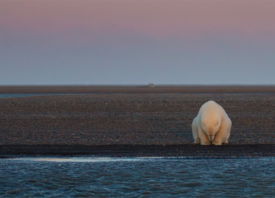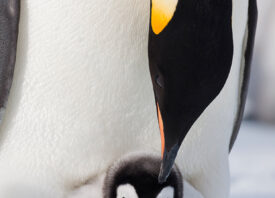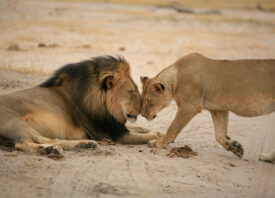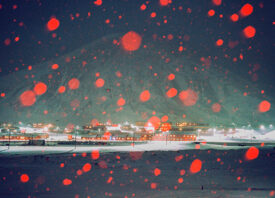Search this site
8 Common Ethical Mistakes in Wildlife Photography (And How to Fix Them)

“With such a slow-to-reproduce animal, bad polar bear management could have dramatic consequences on their numbers. Mother bears and their cubs generally emerge from their dens in March or April, when the cubs are strong enough to survive outdoors and are ready to make the trek to the ice. This period also coincides with the seals’ birthing season on the pack ice — easy meals for the mother bears who have been fasting for as long as eight months at this point.” © Daisy Gilardini
Our planet’s wildlife faces urgent treats from all sides: climate change, deforestation, and animal-human conflict. Today’s wildlife photographers can help advocate for their protection, but they can also cause damage to the environment, intentionally or otherwise. In recent years, for instance, high-profile photographers have come under fire for chasing giraffes, posing models within feet of wild elephants, working with animal handlers, and staging pictures.
“The rise of social media has fueled competition among wildlife photographers and increased pressure to create a ‘viral’ image,” the naturalist, scientific researcher, and photographer Eladio M. Fernandez tells us. “This competitive attitude often causes nature and wildlife photographers to overstep boundaries and violate ethical and environmental considerations, and unfortunately, many of the photographs that we see were obtained to the detriment of plants, animals, or landscapes.
“It is important to start the conversation by admitting we’ve all been guilty at some point or another of crossing ethical boundaries. Most of us did it out of a lack of knowledge or consideration. The first step towards changing our habits is self-awareness.” With that principle in mind, we put together this list of eight common mistakes that can prove harmful for animals, with help from five talented conservation photographers. Refer to this list when planning your next wildlife project, whether it takes place in your backyard or halfway around the globe.
Mistake #1: Wildlife baiting
Feeding might be widespread, but it’s also unethical. “Baiting wild animals in order to get the ‘perfect’ shot has become a normal practice, sadly,” the conservation photographer Daisy Gilardini explains. “Snowy owls in Canada are baited with live mice. All ‘wildlife’ in Japan is bated, from the Sandhill cranes, to the snow monkey, the swans, owls, and Steller’s Sea Eagles. The brown bears and wolverines in Finland are baited with dog food. The list goes on and on.”
If you’re photographing wildlife anywhere in the world, choose a guide or organization who avoids baiting and follows ethical guidelines. “Baiting wild animals is never a good idea for many reasons, and by doing it, you usually alter the animal’s natural behaviour and cause stress,” Gilardini says.
“Wild animals can lose their fear of humans due to bating, and will become aggressive if not fed. Also, if you feed them with human food, this is not healthy for them, and sometimes it can even lead them to obesity. High concentrations of wild animals also increase the chance of fights over territory and food, and often leads to the spread of disease.”
In February, a red fox in Wyoming was caught and euthanized after becoming dangerously habituated to people, due in part to feeding from the public. In January, a famous photographer was accused of feeding a fox in the area. This fox who died was the third in Grand Teton National Park to be killed in four years after relying on humans for food.
These situations are tragic and preventable. Gilardini follows five rules in the field, always: “Respect wildlife and their habitat. Give space and keep quiet. Don’t chase the animals. Learn to interpret signs of stress. No feeding–none–with either dead or live bait.”

Mistake #2: Ill-considered use of flash
“A wildlife welfare issue that I’ve become very aware of recently is the ill-considered use of flash on wildlife, especially with nocturnal animals,” the conservation and wildlife photojournalist Douglas Gimesy tells us. “Depending upon how it’s used and the species, flash can potentially cause negative physical, emotional, and/or behavioural impacts. Unfortunately, there are images out there where it appears such potential impacts might not have been considered or have been unjustifiably ignored.
“For example, I’ve seen images where a flash has been used on a gliding mammal at night, mid-flight. If you stop and think about it, these animals have extremely sensitive eyes, and what the photographer is potentially doing is blinding a gliding mammal whilst it’s spotting for a landing. What would people think if someone blasted a flash into the eyes of a pilot at night, just as they were coming in to land?”
In some situations, using flash might be fine, but in many cases, we just don’t know. It really all depends on many factors like the situation, the species, their unique needs, and the justification. If in doubt, do some research, consult a wildlife expert about the specific scenario, or simply avoid using flash. As Gimesy puts it, “One simple thing photographers can do is to stop and ask, ‘What are the potential negative consequences I might have in trying to take this photo, and can I justify it?’ and then act appropriately.”

Mistake #3: Geo-tagging everything
This one is less about how you make the images and more about how you share them with the world. In the last couple of years, experts have expressed growing concerns over the consequences of geotagging photos on social media; in 2018, for instance, the Jackson Hole Travel & Tourism Board urged visitors to stop tagging their locations, as “influencers” had flocked to the area in search of the perfect Instagram photo. Remote trails became crowded with an influx of tourists.
Spots like Horseshoe Bend have also faced the risk of over-tourism in the Instagram era. In Yellowstone National Park, snap-happy visitors took it a step further by “posing” with bison and tagging their locations. This practice becomes especially dangerous when photographing vulnerable or endangered animals, as poachers and wildlife trackers can use geotags to pinpoint their locations. In 2020, officials at Kruger National Park in South Africa asked people not to share pictures of rhinos and elephants in the area.
“My suggestions on what photographers can do to help rather than harm the environment is to do your research,” the photojournalist Lauren Owens Lambert, whose work centers around conservation and climate change, tells us. “Study your subject and location, and make it happen in a way that does not interfere with the animals’ behavior or survival by being respectful of its space.
“Ethical wildlife photography takes time. A lot of time. Know when it is okay and when it is not okay to geotag an exact area, especially if the subject is a sensitive environment or an endangered species. We want to avoid people gathering in large groups around wild animals.”
Mistake #4: Getting too close
One of the first rules of wildlife photography is keeping your distance. “Something I have noticed in wildlife photography is more people becoming interested in general, which is great, but it can stress the wildlife if people are too aggressive in ‘getting the shot,’” Lambert explains.
“Animals can easily become stressed with groups of people either being too close or following them around. That approach can alter the natural behavior of the animal and is harmful to their health. For example, let’s say a bird of prey makes a kill, but it gets scared off of it because people move in too quickly into the scene to photograph. That means the raptor now has to go spend more energy on another kill, which is hard enough already.
“This human behavior of being too close and too aggressive can also be harmful to the person’s health, as sometimes that animal can be so stressed it can attack or charge. It’s really important to remember that these are wild animals, and they need space. One solution would be a camera trap (with no bait) around a natural feature like a game path or stream. This is normally an unobtrusive way to capture wildlife in their habitat, displaying natural behavior.”

Mistake #5: Not doing your homework.
“Learn as much as you can about the life forms in your viewfinder,” the San Diego-based nature photographer Michael Ready advises. “Doing so will provide insight that will positively impact your photos and ensure that you are not inadvertently causing harm to the species or its habitat.
“My experience photographing quino checkerspot butterfly larvae in the field comes to mind when discussing this principle. This species thrives in unique and delicate habitats with specific features that have developed over centuries, so setting out to photograph them is not just about the awareness of where to step to avoid crushing the caterpillars.
“To start, you must also avoid the life-giving cryptobiotic crust and the tiny sprouts of host plants just starting to push up from the soil. You also have to make sure you didn’t drag any foxtail from your yard into the habitat on your shoes. The entire ecosystem and your impact on it is part of the analysis on how to get the best shot—and it can sometimes mean that you don’t get it at all!”
Mistake #6: Visiting game farms
Captive environments might offer photographers the chance to get close to wildlife, but they inevitably raise ethical concerns. The motives and intentions of these facilities can vary drastically; there are accredited sanctuaries out there doing live-saving rescue and rehabilitation work, but there are also many facilities with histories of mistreatment, exploitation, and animal welfare violations.
Game farms might be common, but they are far from ethical, as life for animals on these farms is often short and difficult. They’re bred for profit and entertainment, and they spend much of their lives confined behind bars. Food and prods are often used to manipulate the animal’s behavior, and many publications and organizations today will not allow photos made at game farms for these reasons.
If you must photograph animals in captivity, do your research. Consult conservationists and animal advocates, and choose a reputable, accredited sanctuary with a focus on conservation, rescue, and rehabilitation. Finally, be honest and explicit in your captioning. Gilardini tells us, “In some cases, photographing captive animals can serve a specific conservation purpose, but it must be governed by strong, ethical rules about the welfare of the animal, and should always be captioned as so.”

“A portion of the revenues generated by this annual tourism goes to the Guadalupe Island Conservation Fund, a program supporting the Bio-Sphere management and scientific research vital to understanding and protecting this iconic species.” © Michael Ready
Mistake #7: Staging photos.
“Wildlife photography unfortunately has a history of occasional fakery: photographers staging scenes and then misrepresenting them as real wild events in nature,” Ready explains. “In the seeking of internet fame, some extreme cases of this have been turning up in novelty scenes of wildlife manipulated into artificial poses and passed off as a natural moment.
“Habitat destruction and cases of animal cruelty have sometimes been an unfortunate outcome of those seeking the perfect shot. Maybe you’ve seen some of the images of frogs ‘riding’ on the backs of beetles or snails, and other whimsical scenes that would never occur in nature. Many, however, don’t recognize it as artificial–the ‘cute’ factor compels and the images are widely shared.
“This kind of manipulation not only misrepresents animal behaviors, but can also be stressful and cruel for the animals involved. Thankfully, images of this sort are now being called out for what they are and are being discouraged more frequently. The natural world is intrinsically captivating and mysterious; we don’t need to embellish for it to be valued and celebrated in photography.”

Mistake #8: Anthropomorphizing
This kind of problematic “embellishing” can also take the form of anthropomorphism. “Another issue arises when either photographers or writers anthropomorphize an animal,” Lambert says. “I understand why people do this, but I don’t think it’s helpful.
“Yes, we can tell when an animal is hunting, scared, or defensive, trying to get a mate, etc., but not when it’s ‘in love’ or ‘jealous’ or ‘praying.’ When people anthropomorphize, it is detrimental to the education of what’s really happening in the image and therefore represents a lost opportunity to understand natural behavior and talk about conservation.”

The way forward
If irresponsible photography can harm landscapes and wildlife, it’s equally important to recognize that ethical photography can help protect our planet. For some, that might mean teaming up with a local wildlife rehabilitation group and helping to share their stories; for others, maybe it comes down to hosting a print sale to benefit conservation.
“The same sense of competitiveness that drives people to take ‘viral photos’ can be re-focused to do good,” Fernandez tells us. “If you’re a wildlife photographer, collaborating with biologists and NGOs is a great way to put your images to good use. As conservation photographers, we talk about ‘images with purpose,’ and that’s a valuable idea for all photographers.
“A good place to start is by asking yourself, ‘How can I make the smallest footprint with my photography practice?’ Your work could have significant scientific importance. You could have the only photograph of a particular plant, animal, or a behavior that would be extremely useful to a biologist or an institution who studies that organism.
“Finally, not everything we encounter in nature is pretty. We should take the time to make images of pollution, deforestation, forest fires, overfishing, or other stories that show our impact on the environment. These can be just as important as beautiful, pristine landscapes. Activists who fight these issues on a daily basis need support from photographers, and our images have the potential to be agents for positive change.”

All of the photographers featured in this story are part of The International League of Conservation Photographers, a non-profit organization supporting environmental and cultural conservation through ethical work, either as iLCP Fellows or Emerging League Photographers. We recommend the organization as a resource for any nature or wildlife photographer, beginning with their Ethical Standards and Principles. You can follow their work on Instagram at @iLCP_photographers.



